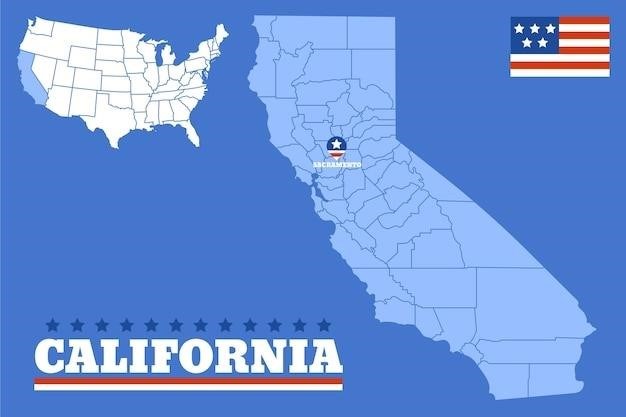governing california in the twenty-first century 9th edition pdf

Governing California in the 21st Century⁚ A Comprehensive Overview
This overview delves into the intricacies of governing California in the 21st century, examining the state’s unique political landscape, key institutions and processes, major policy challenges, and the future trajectory of the Golden State. The information is based on the Ninth Edition of “Governing California in the Twenty-First Century,” a widely recognized textbook exploring California politics and government.
Introduction
California, the most populous state in the US, faces a complex array of challenges and opportunities in the 21st century. Its political landscape, characterized by a unique culture, diverse demographics, and a dynamic interplay of political parties and interest groups, shapes its governance. This Ninth Edition of “Governing California in the Twenty-First Century” provides a comprehensive exploration of the state’s political system, highlighting its key institutions, processes, and major policy challenges. The book encourages critical thinking about how these factors impact the lives of Californians and the future of the state.

The Political Landscape of California
California’s political landscape is a complex tapestry woven from diverse threads. It is a state known for its progressive leanings, but also for its pragmatic approach to governance. The state’s unique political culture, shaped by its history, demographics, and economic dynamism, influences the dynamics of political parties and interest groups. The Ninth Edition of “Governing California in the Twenty-First Century” delves into these complexities, highlighting how the political landscape impacts the state’s governance and policy decisions.
The State’s Unique Political Culture
California’s political culture is a distinctive blend of progressivism and pragmatism. The state has a long history of social activism and a commitment to progressive values, evident in its policies on environmental protection, social justice, and individual rights. Yet, California also exhibits a practical approach to governance, balancing these progressive ideals with the need for economic stability and fiscal responsibility. This unique blend shapes the state’s political landscape, influencing the priorities of political parties, the actions of elected officials, and the engagement of citizens in the political process. The Ninth Edition of “Governing California in the Twenty-First Century” provides insights into this dynamic political culture, highlighting its evolution and its impact on the state’s governance.
The Role of Political Parties
Political parties in California play a crucial role in shaping the state’s political landscape. The Democratic Party holds a significant majority in both houses of the state legislature and has dominated gubernatorial elections for decades. The Republican Party, while less dominant, remains a significant force, particularly in certain regions of the state. The Ninth Edition of “Governing California in the Twenty-First Century” examines the dynamics between these parties, exploring how their platforms, strategies, and internal divisions influence policymaking, elections, and the overall direction of California politics. The book also delves into the influence of third parties and independent candidates, highlighting the evolving political landscape in the Golden State.
The Impact of Demographics
California’s diverse and ever-changing demographics profoundly impact its political landscape. The state’s growing population, fueled by immigration and internal migration, has led to shifts in racial and ethnic composition, age distribution, and geographic concentration. The Ninth Edition of “Governing California in the Twenty-First Century” explores how these demographic trends influence voting patterns, political representation, and policy priorities. The book examines the impact of California’s large Hispanic population, its aging population, and its increasingly urbanized character, highlighting how these factors shape the political agenda and the challenges faced by policymakers in addressing issues such as education, healthcare, and housing affordability.
Key Institutions and Processes
The Ninth Edition of “Governing California in the Twenty-First Century” provides a comprehensive analysis of the key institutions and processes that govern California. The book delves into the structure and functions of the California State Legislature, examining the roles of the Assembly and the Senate, as well as the legislative process. It also explores the Governor’s Office, outlining the powers and responsibilities of the Governor, including executive orders, veto power, and budget authority. The judicial branch is examined, with a focus on the California Supreme Court and the state’s system of lower courts. The book also analyzes the role of interest groups in California politics, exploring their influence on policymaking and the dynamics of lobbying and advocacy.
The California State Legislature
The Ninth Edition of “Governing California in the Twenty-First Century” provides a detailed analysis of the California State Legislature, the bicameral body responsible for enacting state laws. The book examines the structure and functions of both the Assembly and the Senate, detailing their respective roles in the legislative process. It highlights the key committees within each chamber, their areas of jurisdiction, and the influence they exert on policy development. The text also explores the dynamics of legislative leadership, including the roles of the Speaker of the Assembly and the President pro Tempore of the Senate, and their impact on legislative priorities.
The Governor’s Office
The Ninth Edition of “Governing California in the Twenty-First Century” offers a comprehensive analysis of the Governor’s Office, the executive branch of California state government. The text examines the powers and responsibilities of the Governor, including their role in proposing legislation, vetoing bills, appointing judges and cabinet members, and leading the state’s response to emergencies. The book also explores the Governor’s influence on public policy, their relationship with the legislature, and the impact of their personality and political skills on their effectiveness in office.
The Judicial Branch
The Ninth Edition of “Governing California in the Twenty-First Century” provides an in-depth analysis of the California judicial branch, encompassing the state’s court system. It examines the structure and function of the California Supreme Court, Courts of Appeal, and Superior Courts, highlighting the role of judges in interpreting state laws and resolving legal disputes. The text also explores the process of judicial selection in California, including the appointment and election of judges, and the impact of public opinion and political pressure on the judiciary.
The Role of Interest Groups
The Ninth Edition of “Governing California in the Twenty-First Century” delves into the multifaceted role of interest groups in shaping California’s political landscape. It explores how these groups, representing diverse interests such as labor unions, business associations, environmental organizations, and advocacy groups, engage in lobbying, campaign contributions, and public education to influence policy decisions. The text analyzes the effectiveness of interest groups in advocating for their agendas, examining factors such as group resources, political connections, and public support. It also discusses the potential for interest group influence to create inequalities in political representation and policy outcomes.
Major Policy Challenges
The Ninth Edition of “Governing California in the Twenty-First Century” examines the complex policy challenges facing California in the 21st century. The text delves into critical issues such as the environment and climate change, economic inequality and housing affordability, immigration and diversity, and education and healthcare. It analyzes the political dynamics surrounding these challenges, exploring the competing interests and perspectives of various stakeholders. The book also examines the policy responses implemented by California’s government, evaluating their effectiveness and the potential for future action. This section provides a comprehensive overview of the major policy challenges confronting California, highlighting their significance in shaping the state’s future.
The Environment and Climate Change
The Ninth Edition of “Governing California in the Twenty-First Century” extensively explores the environmental and climate change challenges facing California. It highlights the state’s vulnerability to climate change impacts, such as rising sea levels, wildfires, and droughts. The text delves into the political and economic dimensions of addressing these challenges, examining the state’s policies and initiatives aimed at reducing greenhouse gas emissions, promoting renewable energy, and adapting to climate change. It also discusses the role of public opinion, interest groups, and the judiciary in shaping California’s environmental policies. This section provides a comprehensive analysis of California’s environmental and climate change challenges, illuminating the complexities and controversies surrounding their management.
Economic Inequality and Housing Affordability
The Ninth Edition of “Governing California in the Twenty-First Century” addresses the critical issues of economic inequality and housing affordability in California. It examines the state’s high cost of living, particularly in major metropolitan areas, and its impact on residents, especially those with lower incomes. The text explores the factors contributing to these challenges, such as income disparities, limited affordable housing options, and rising housing costs. It also analyzes the state’s efforts to address these issues, including policies aimed at increasing affordable housing development, promoting job growth, and providing social services to low-income individuals and families. This section offers a nuanced understanding of the complex interplay between economic inequality and housing affordability in California, shedding light on the challenges and potential solutions.
Immigration and Diversity
The Ninth Edition of “Governing California in the Twenty-First Century” provides a thorough examination of immigration and diversity in California. It delves into the state’s long history of immigration, its diverse population, and the political and social implications of these dynamics. The text analyzes the impact of immigration on California’s economy, demographics, and social fabric. It also explores the state’s policies and programs related to immigration, including those addressing undocumented immigrants, refugees, and asylum seekers. This section offers insights into the challenges and opportunities presented by California’s diverse population and the role of the state in navigating these complexities.
Education and Healthcare
The Ninth Edition of “Governing California in the Twenty-First Century” dedicates a significant portion to analyzing the state’s complex and multifaceted education and healthcare systems. It examines the challenges and opportunities facing California’s public education system, including funding disparities, student achievement gaps, and the growing need for early childhood education. The text also explores the state’s healthcare system, highlighting the impact of the Affordable Care Act, the challenges of providing healthcare to a diverse population, and the ongoing debate over access to healthcare and its affordability. Through these analyses, the book provides a comprehensive understanding of the critical role that education and healthcare play in the lives of Californians and the crucial decisions that the state government must make in these areas.
The Future of California
The Ninth Edition of “Governing California in the Twenty-First Century” explores the future of California, examining emerging trends and issues that will shape the state’s political, economic, and social landscape. The text delves into the impact of technology and innovation on California’s economy and society, analyzing the rise of Silicon Valley and the state’s role as a global leader in technological advancement. It also examines the state’s position in the global economy, considering the challenges and opportunities presented by globalization, trade, and immigration. By examining these critical factors, the book provides valuable insights into the future direction of California, highlighting the challenges and opportunities that lie ahead for the Golden State.
Emerging Trends and Issues
The Ninth Edition of “Governing California in the Twenty-First Century” explores emerging trends and issues shaping California’s political and social landscapes. The book analyzes the ongoing impact of the COVID-19 pandemic on the state, highlighting the challenges of economic recovery, public health, and social equity. It examines the growing concerns regarding climate change and its effects on California, discussing the state’s efforts to mitigate its impact through policies and initiatives. The text also delves into the challenges of housing affordability and homelessness, exploring the complex factors contributing to these issues and potential solutions. By examining these critical issues, the book provides a comprehensive understanding of the evolving challenges and opportunities facing California in the 21st century.



Leave a Reply
You must be logged in to post a comment.